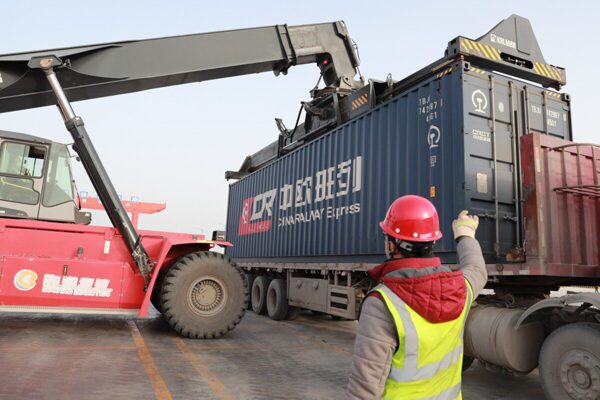Sep 09, 2020 / News
China-Europe freight trains gather steam amid surge in B2B goods bought online

The China-Europe Railway Express left Chongqing in southwestern China last week, bound for Budapest, Hungary, making it the first train dedicated exclusively to delivering goods ordered by European businesses via e-commerce platforms, according to the General Administration of Customs.
The freight train, travelling on what is known as the Yuxinou international railway corridor, carried 33 million yuan (US$4.82 million) worth of commercial goods – including clothing, shoes and household goods – that European firms ordered from Chinese companies in business-to-business (B2B) transactions.
The dedicated train trip dovetails with the Chinese government’s plan to accelerate non-traditional export methods. In June, China announced it would boost B2B exports by streamlining its supply chains and reducing paperwork.
In August, China added Chongqing, along with 11 other cities, to its list of pilot e-commerce hubs that have been awarded preferential tax treatment to support their online trading operations.
Chinese customs authorities say the future looks bright for domestic exports in B2B cross-border e-commerce transactions via the railway. They note that it is a relatively flexible and convenient option for traders, especially given China’s push to reduce red tape by simplifying customs declarations, speeding up customs clearances, and adding more foreign warehouses to which traders can ship their goods before they are dispatched to end-users.
“The model of ‘cross-border e-commerce B2B, plus China-Europe trains, plus the use of foreign warehouses’ has become a new path for many goods export options,” the General Administration of Customs said in a statement. “Through this path, foreign trade companies can enter the global market more easily and effectively.”
Customs authorities in Chongqing are also planning to expand the number of e-commerce train journeys by attracting more B2B traders to its hub, the administration said. Between May and July, there were 200 China-Europe Railway Express (Chongqing) trips to Europe a month.
In the first half of the year, China’s cross-border e-commerce import and export trade increased 26.2 per cent compared with the same period last year, the administration added.
B2B e-commerce trade is set to enter a high-growth period in the next five years, as the internet infrastructure for online trading improves, according to a report earlier this year by Bain & Co and e-commerce firm Alibaba Group. The total value of B2B deals in China could more than triple to 2.4 trillion yuan (US$350.8 billion) by 2024 from 700 billion yuan last year, the report added. Alibaba owns the South China Morning Post.
B2B e-commerce platform DHGate.com, whose sales by Chinese suppliers to foreign businesses boomed this spring, has been using the China-Europe Railway Express to send goods to foreign warehouses in Europe. For example, the company has started exporting electric scooters from Chengdu, Sichuan province.
“Given the standardised business operations between enterprises and the large volume of order transactions, B2B exports in cross-border e-commerce will be the new mainstream mode of global trade,” DHgate.com chief executive Diane Wang predicted.
Other smaller freight trains dedicated to transporting e-commerce goods have also started making the trip to Europe. Last year, a regular e-commerce train began running from Yiwu in east China’s Zhejiang province to Zhengzhou in central China to Liege in Belgium.
And the e-commerce trade flow is now going both ways.
Chinese e-commerce giant JD.com has been moving goods to and from Germany by rail, including food and beverages, home furnishings and automotive supplies.
And China-Europe train trips are set to increase, especially after China’s state-owned railway operator China Railway said two weeks ago that it would accelerate the development of a high-speed freight network to support the nation’s e-commerce network.
The number of freight trains travelling from China to Europe reached a record high of 1,247 in August, up 62 per cent compared with a year earlier, according to the latest data from China Railway. This marked the sixth consecutive month that China-Europe freight train traffic has registered double-digit percentage growth, year on year.
The increase in demand for freight trains comes amid the ongoing coronavirus pandemic, which has restricted international air and sea transport and pushed up associated costs. This has made shipping by train a more competitive option.
But beyond increasing exports and lifting economic activity post Covid-19, trade experts see e-commerce trade delivered via rail as a good way to circumvent geopolitical tensions that may hurt traditional exports. They say it could also help China diversify its trade links among the countries that are part of its Belt and Road Initiative, several of which are along the China-Europe railway route.
The China-Europe Railway Express (Chongqing) line is just one of the many China-Europe freight lines that have been developed as part of the large-scale connective infrastructure phase of the ambitious belt and road project.
Suresh Dalai, senior director for Asia at management consulting firm Alvarez and Marsal, said that even though China’s push for B2B e-commerce existed before Covid-19, the pandemic has prompted importers globally to become more “accustomed to and comfortable with ordering from China” online.
“The environment created by Covid-19 – that is, a critical need by global customers for Chinese products, more comfort with doing cross-border business from China, a push by Chinese e-commerce companies, and the availability of ground transport from China to Europe – does mitigate some of the export delays caused by geopolitical tensions, and [it] increases significantly the value of the [Belt and Road] Initiative,” he said.

